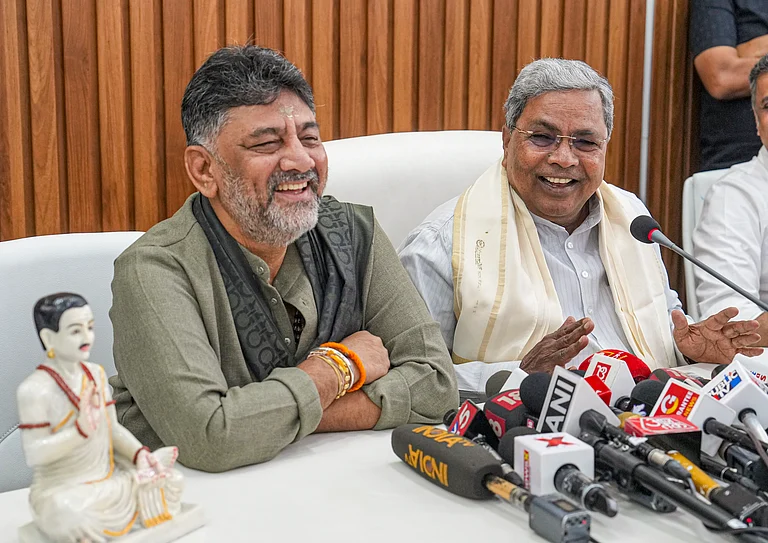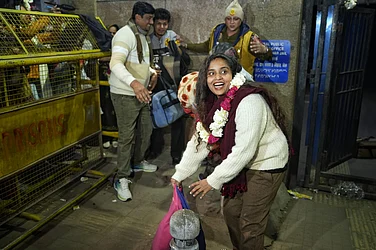The India Meteorological Department (IMD) on Tuesday predicted prevalence of severe cold weather conditions, along with dense to very dense fog over northwest India during the next four to five days.
A dense layer of fog persists over the Indo-Gangetic plains and the condition is likely to persist for some more days, the weather department said.
Delhi shivers on 'cold day'; City Wrapped in shallow fog
Delhi's minimum temperature on Wednesday morning plunged to 4.4 degrees Celsius, the season's lowest, making the national capital colder than Dharamsala, Nainital and Dehradun.
'Cold day' conditions gripped Delhi on Tuesday as frosty winds from the Himalayas swept through the plains, according to India Meteorological Department.
The maximum temperature dropped five notches below normal at many places in the national capital including Lodhi Road, Palam, Jafarpur and Mayur Vihar, the IMD said.
Shallow fog wrapped parts of the city in the morning, reducing visibility and affecting vehicular movement.
A layer of 'dense' to 'very dense' fog over the Indo-Gangetic plains and adjoining central and eastern parts of the country affected rail and air traffic.
At least 21 trains to Delhi were delayed by one-and-a-half to five hours due to the foggy weather, an Indian Railways spokesperson said.
An official at the Indira Gandhi International Airport here said five flights were diverted to Jaipur on Monday night due to bad weather in Delhi.
"Due to fog and low cloud cover, severe cold day conditions were observed over Punjab, Haryana, Uttar Pradesh and Bihar. Cold day conditions were observed over some pockets of Delhi and isolated areas in Rajasthan and Madhya Pradesh," an IMD official said.
A 'cold day' is when the minimum temperature is less than or equal to 10 degrees Celsius below normal and the maximum temperature is at least 4.5 degrees Celsius below normal. A 'severe cold day' is when the maximum temperature is 6.5 degrees Celsius or more below normal.
The Safdarjung observatory, Delhi's primary weather station, recorded a minimum temperature of 8.5 degrees Celsius -- a notch above normal.
The maximum temperature in the national capital settled at 16.1 degrees Celsius, a departure of three degrees from normal.
'Moderate' to 'dense' fog is predicted in Delhi for the next two days. Coldwave conditions are set to return on the weekend and the mercury may drop to 4 degrees Celsius, the IMD said.
It said 'dense' to 'very dense' fog and 'cold day' conditions are very likely to continue over northwest India during the next four to five days.
"Coldwave conditions are likely to continue over northwest India during the next three days," it said, adding that some relief is expected thereafter.
According to the IMD, 'very dense' fog is when visibility is between 0 and 50 metres, 51 and 200 metres is 'dense', 201 and 500 metres 'moderate', and 501 and 1,000 metres 'shallow'.
In the plains, the weather office declares a cold wave if the minimum temperature dips to four degrees Celsius or is 10 degrees Celsius or below and 4.5 notches below normal.
A severe cold wave is when the minimum temperature dips to 2 degrees Celsius or the departure from normal is more than 6.4 degrees Celsius.
The 24-hour average Air Quality Index (AQI) of the national capital was recorded at 385 at 4 pm.
An AQI between 201 and 300 is considered 'poor', 301 and 400 'very poor', and 401 and 500 'severe'.
The Commission for Air Quality Management had on Monday said curbs under Stage III of the Graded Response Action Plan, including a ban on non-essential construction and demolition work, would remain in force in Delhi-NCR as pollution levels were showing an upward trend.
Click here to select all and copy text
Biting cold in Rajasthan, weather office issues 'Orange Alert' for several districts
Severe cold and fog threw daily life out of gear in many regions of Rajasthan with Fatehpur recording the lowest minimum temperature at minus 1 degree Celsius on Monday night.
According to the Met department, the minimum temperature was minus 0.9 degree in Churu on Monday night, 2.4 degrees in Sangaria, 2.6 degrees in Pilani, 3.0 degrees in Sikar, 3.7 degrees in Ganganagar, 4.5 degrees in Nagaur, 4.9 degrees in Chittorgarh. Bikaner recorded a minimum temperature of 6.9 degrees Celsius.
The Regional Meteorological Centre here said there was dense fog in some parts of eastern and northern Rajasthan in the morning. In Jaipur, the maximum and minimum temperatures were recorded at 20.8 and 5.3 degrees Celsius, respectively.
An 'Orange Alert' for an extreme cold wave in several districts, including Churu, Jhunjhunu and Sikar, has also been issued by the weather office.
Slight respite in cold wave in Kashmir
Even with the mercury staying several degrees below freezing point across the valley, Kashmir got a slight respite from intense cold wave conditions, officials said on Tuesday.
Srinagar recorded a low of minus 4.4 degrees Celsius Monday night compared to minus 5.4 degrees Celsius a night earlier.
Pahalgam in south Kashmir's Anantnag district, which also serves as a base camp for the annual Amarnath Yatra, recorded a low of minus 7.2 degrees Celsius.
The minimum in Gulmarg, the famous ski resort in north Kashmir's Baramulla district, was minus 9.2 degrees Celsius, weather officials said.
The resort was also the coldest recorded place in Jammu and Kashmir this winter
The MeT office has forecast dry weather over the next few days for the region leading to colder nights and slightly warmer days.
Qazigund, the gateway town to the Valley, also witnessed a slight appreciation in minimum temperature Monday night. It registered a low of minus 5.0 degrees Celsius.
In Kupwara, a frontier district, the minimum temperature settled at minus 5.3 degrees Celsius, while Kokernag in south Kashmir recorded a low of minus 4.1 degree Celsius, the officials said.
The below-than-normal precipitation this winter has resulted in an increase in respiratory problems for the residents, particularly children and elderly, doctors said.
The sub-zero temperatures have resulted in the freezing of several waterbodies in the valley.
Kashmir is currently under the grip of 'Chilla-i-Kalan,' the 40-day harshest weather period when the chances of snowfall are maximum and most frequent.
'Chilla-i-Kalan' begins on December 21 and ends on January 30.
The cold wave continues even after that with a 20-day-long 'Chillai-Khurd' (small cold) and a 10-day-long 'Chillai-Bachha' (baby cold) following it.
Most areas of the valley received snowfall on Thursday.
Biting cold sweeps Punjab, Haryana; Bathinda shivers at 1.2 deg C
A biting cold swept Punjab and Haryana on Tuesday with minimum temperatures settling below normal at many places.
A thick blanket of fog in the morning enveloped several parts of both states.
According to the MeT Department's weather report, Bathinda was the coldest place in Punjab with a minimum temperature of 1.2 degrees Celsius, while Sirsa was the coldest in Haryana registering a minimum of minus 3 degrees Celsius.
Gurdaspur recorded a low of 2 degrees Celsius, Ludhiana 5.8 degrees Celsius, Patiala 4.8 degrees Celsius, Pathankot 6.6 degrees Celsius, Faridkot 4.8 degrees Celsius, while Amritsar shivered at a low of 5.6 degrees Celsius.
In Haryana, Narnaul recorded a minimum temperature of 4 degrees Celsius, Hisar a low of 4.5 degrees Celsius, Bhiwani 6.9 degrees Celsius, and Jhajjar 5.7 degrees Celsius.
Chandigarh, the common capital of the two states, recorded a low of 6.6 degrees Celsius.
(With PTI Inputs)


























